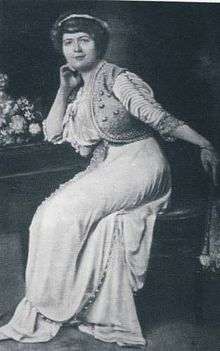Behice Hanım
| Behice Hanım | |||||
|---|---|---|---|---|---|
 | |||||
| Born |
Behiye Maan 10 October 1882 Adapazarı, Ottoman Empire | ||||
| Died |
25 October 1969 (aged 87) Istanbul, Turkey | ||||
| Burial | Yahya Efendi cemetery | ||||
| Spouse | Abdul Hamid II | ||||
| Issue |
Şehzade Ahmed Nureddin Efendi Şehzade Mehmed Badreddin Efendi | ||||
| |||||
| House |
House of Margania (by birth) House of Osman (by marriage) | ||||
| Father | Albus Maan | ||||
| Mother | Nazli Kucba | ||||
| Religion | Sunni Islam | ||||
Behice Hanım (Ottoman Turkish: بھیجه خانم; born Behiye Maan; 10 October 1882 – 22 October 1969) was the Empress pf the Ottoman Empire as the twelfth wife of Sultan Abdul Hamid II. Behice was the most extravagant and wasteful wife of Sultan Abdul Hamid II. Her spending and debt contributed to the overthrow of the Sultan. Behice Hanımefendi tripled the spending of the court within five years and thus became a symbol of wealth and extravagance.
Early life
Behice Hanım was born on 10 October 1882 in the Beynevid village, Adapazarı. Born as Behiye Maan, she was the daughter of an Abkhazian noble, Albus Bey Maan and his Abkhazian wife Nazli Hanım Kucba.[1] She was the great grand daughter of the famous companion of the last ruler of Abkhazia Mikhail Shervashidze, Lieutenant General Katz Bey Maan. She was a relative of the wife of Halil Kut Pasha, uncle of Ismail Enver Pasha. She was the eldest among the six children. Her father received through his cousin Sazkar Hanım, who was also married to Sultan Abdul Hamid, a job on the farm. When he heard that Abdul Hamid was seeking a bride for his son Burhaneddin, he brought his daughter to the court, and presented her to the Sultan. But Abdul Hamid was so taken by the beauty of the young girl that he married her himself.
Marriage
At the age of about eighteen, Behice married Abdul Hamid on 10 May 1900 in the Yıldız Palace, Istanbul. Upon the birth of her children, Behice increased her spending. She began to bring her relatives at the court and begged the Sultan for more pensions for them. In 1902 her father moved into an annual pension of 300,000 pounds and received a mansion near the Yildiz Palace. The wedding of her sister Tasvire Hanım was arranged in the Yıldız Palace. She received a dowry of 90,000 pounds and her husband was given a job on the farm. Her unmarried sisters received a pension of 50,000 pounds a year and got their weddings, each of them still £50,000 dowry. Her mother had her own courtly society in the sultan's palace, consisting of 20 servants. Only her wardrobe surpassed everything. Constantly new dresses were ordered from abroad. Not even the principal consort of the Sultan herself led an extravagant life so as Behice Hanım.
The spending finally reached such a high level that the finance minister complained about this and also the Sultan Abdul Hamid II himself began to publicly criticize Behice. However, this was not successful and the spending continued to rise and debts to Armenian bankers were made. In 1903 Prince Badreddin died suddenly and the expenditure was reduced only temporarily. However between the years 1901 and 1903 Behice Maan had the Ottoman Empire cost about 2,000,000 pounds. One year after the death of her son the spending began to rise again. Behice bought three mansions at the same time on the Bosporus, had them painted from the personal artist of the Sultan and ordered jewelry from the jewelers for themselves and their relatives of worth 150,000 pounds. However, Behice had not succeeded in binding the sultan to her, and already in 1904, Abdul Hamid II had moved to another young noblewoman. Soon, he made his new favorite Empress Naciye Hanım his 13th wife, who became one of the two most favorite wives of Abdul Hamid II (as other being Empress Müşfika Kadın). At the overthrow of her husband in 1909 Behice Hanım did not accompany Abdul Hamid II into exile to Salonica. Instead, she stayed in Istanbul, where she and her son lived until the expulsion of the Sultan's family in the hotel "Maçka Palas".
Death
In 1924 she went with her son to Naples. It was not until 1969 when she was allowed to re-enter Turkey and died seven months after their return to Suadiye on 22 October 1969 and was buried in Yahya Efendi Cemetery.[2]
Issue
Together with Abdul Hamid, Behice had two children:
- Şehzade Ahmed Nureddin Efendi (22 June 1901, Istanbul Yıldız Palace - 13 October 1903, buried in Yahya Efendi Cemetery);
- Şehzade Mehmed Badreddin Efendi (2 August 1902, Adapazarı - December 1944, Paris, France, buried in Bobigny Cemetery).
Titles and styles
- 10 May 1900 - 17 June 1901:
Behice İkinci Hanımefendi Hazretleri (Her Highness The Second Lady Consort Behice) or İkinci Gözde (The Second Favour Lady) - 17 June 1901 - 21 January 1909:
Behice Başhanımefendi Hazretleri (Her Highness The First Lady Consort Behice) or Baş Gözde (The First Favour Lady) - 21 January 1909 - 27 April 1909:
Devletlu Dördüncü İkbal Behice Hanımefendi Hazretleri (Her Highness The Fourth Honoured Lady Consort Behice)
References
- ↑ Bir Çerkes prensesinin harem hatıraları. L & M. 2004. ISBN 978-9-756-49131-7.
- ↑ Christopher Buyers. "The Royal Ark – Royal and Ruling Houses of Africa, Asia, Oceania and the Americas". 4dw.net.